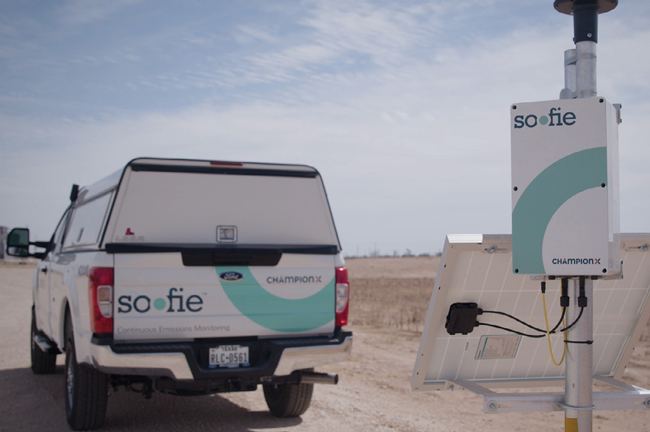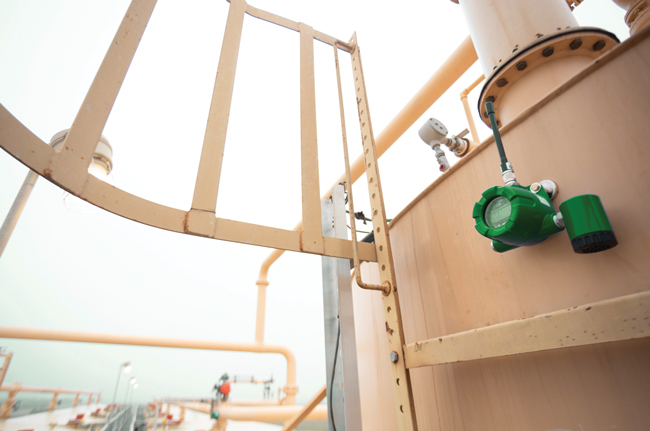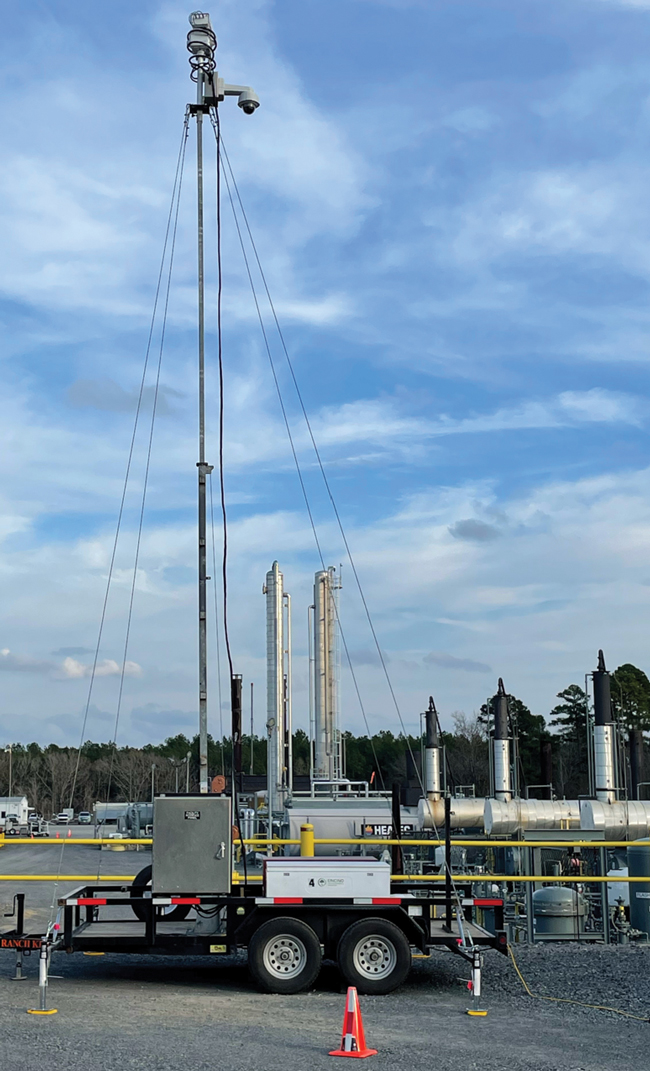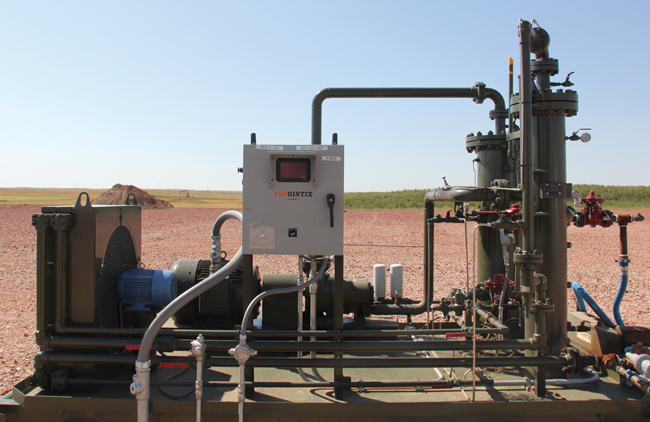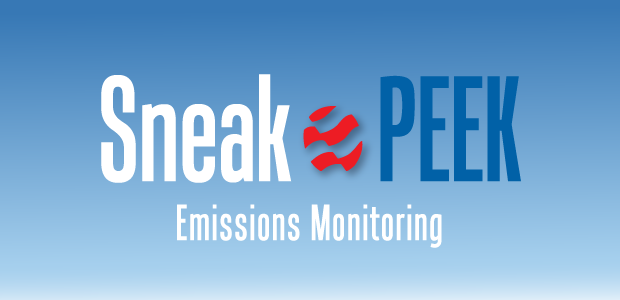
Innovations Drive Powerful Advances In Emissions Management
By Colter Cookson
Finding and fixing methane emissions has become a key component of many oil and gas companies’ operations. Whether motivated by regulatory compliance, voluntary emission reduction initiatives or a desire to sell certified natural gas, these operators are searching for the most cost-effective abatement strategies.
Identifying the best approaches for each site or company starts with understanding its emissions profile, suggests John Tang, director of strategic planning for emissions at ChampionX. Often, sites’ actual emissions differ from estimates based on generic emission factors for the equipment they contain, as these factors are for population-wide emissions counting and do not account for unusual events, equipment vintage and individual operating parameters.
Leak detection and repair (LDAR) surveys using handheld optical gas imaging cameras can be an important first step to understanding emissions, but Tang predicts that most companies will combine them with other techniques.
That is partly because experience from mandatory LDAR surveys shows they eventually reach a point of diminishing returns. “In the United States, surveys need to be done quarterly. Canada mandates three surveys a year, though new regulations may make them monthly,” he describes. “For the past few years, the number of leaks identified by each survey has fallen as companies have improved their repair and maintenance programs.”
Given that progress, Tang says LDAR surveys will likely become more frequent in the years ahead. They also will involve stricter scrutiny and documentation.
“Through proposed changes to Appendix K, the Environmental Protection Agency has outlined detailed guidelines that cover not only how often surveys need to take place, but also how they must be performed. This includes the route taken, the documentation necessary to define each leak, and the training requirements for everyone involved in the survey,” Tang notes.
The proposed changes stipulate that novices perform several surveys under the guidance of a senior operator before they can conduct surveys independently. To facilitate such supervision and streamline other compliance tasks, Tang says, ChampionX has introduced a new optical gas imaging camera that streams data wirelessly. “Instead of having six people hover around an individual camera to see what the operator is looking at, everyone can pull out their phones or tablets to visualize exactly what the camera is seeing,” he describes. “This makes it much easier for senior operators to oversee and train new surveyors.
“On top of that, the camera includes highly accurate global navigation satellite system (GNSS) positioning and records technicians’ routes, what they are pointing at and how long they pointed. And through a unique ‘Gas Enhancement Mode,’ the camera identifies, quantifies and tags the gases it observes,” Tang continues. “These features create a digital audit trail while allowing users to focus on performing the survey correctly.”
According to Tang, a well-done survey can be extremely informative. “OGI surveys identify all emissions, whether fugitive or intentional,” he assures. “Each survey only captures a moment in time, but once a company has a solid sample size of 8-10 surveys, it can start correlating venting to the operational setting and configuration of the facility. These correlations help the company predict emissions and potentially reduce them.”
To illustrate the possibilities for optimization, Tang points to a midstream facility with several compressors. “By combining emissions and operational data, we gather operational insights for optimal facility configurations, such as whether it is better to operate every compressor at 70% capacity or run a few at 90%,” he says. “Over time, the resulting efficiency gains can add up to lower costs and emissions.”
Continuous Monitoring
To gain an even deeper understanding of emissions, Tang recommends continuous monitoring systems. These systems watch for emissions constantly and trigger an alert when something unusual happens, allowing emissions to move to a “survey by exception” model. This model enables operators to perform surveys when necessary, usually yearly or after the continuous monitors spot a leak.
The benefits of continuous monitoring can go beyond detecting emissions, as emissions can indicate other operational problems. “For one of our clients, a monitor picked up anomaly emissions at a remote facility around 9 p.m. and dispatched an alert to an on-call technician. Within 90 minutes, that technician arrived at the facility and discovered the emissions’ source. While methane had triggered the alarm, it was leaking from a sight glass alongside oil,” he relates. “Had the leak continued, the costs would have been much higher.”
Continuous emissions monitors can quantify and mitigate emissions that can be difficult to catch with periodic leak detection and repair surveys alone. As an example, ChampionX says the monitors can alert operators when pressure relief valves stay open even after pressures have returned to safe levels, a common source of unexpected emissions.
In addition to allowing fast and efficient responses, continuous monitoring can show emission trends. Ideally, Tang says, the monitors will confirm that emissions are shrinking as operators make changes to address them and guide such changes by revealing emissions that are difficult to capture in periodic surveys.
“One of the biggest unknowns in emissions estimates is how often pressure relief valves activate and how long they stay open,” Tang illustrates. “Many of these valves are old enough that they may not close completely even after pressures have returned to a safe range. With continuous monitoring, we know when valves stay open too long and can send someone to investigate why.”
Whether a leaking valve is discovered through a survey or continuous monitoring, it can lead to long-term improvements not just with emissions but also with reliability and maintenance programs. “In the short term, companies can fix a valve leak with grease,” Tang considers. “This works, but if the valve has to cycle frequently, the grease will migrate and the leak will return. No one can afford to replace every valve that leaks, but with a sophisticated monitoring system instead of industry emissions estimates, they can identify the most problematic ones and replace them.”
Where deploying continuous monitoring makes the most sense depends in part on a location’s accessibility, how frequently regulators require information, the value of the lost methane and whether the facility is subject to emissions taxes, Tang outlines. He says instrumenting facilities can be quite affordable, with some only requiring a few sensors or an investment of a few thousand dollars.
The information continuous monitoring provides occasionally unlocks cost savings in other areas, he adds, such as optimized electrical automation, and health and safety programs. “For example, it is common to see compressor buildings classified as Class I, Division I based on assumptions about the explosive gasses in the area,” Tang says. “If the monitors show that the building qualifies as Class I, Division II, the owner can use less expensive systems to monitor machine health. In general, Class I, Division II equipment costs about 40% less.”
Holistic View
Although he describes continuous monitoring as an important component of emissions management, Tang stresses that progress will require a diverse tool set that includes everything from handheld OGI cameras to drones, helicopters, planes and satellites. OGI cameras and drones can provide detailed information on a well pad or facility, while long-range drones, planes and satellites cover multiple facilities in asset-dense regions or geographically dispersed assets such as pipelines.
“There is no silver bullet,” Tang says. “Every tool has pros and cons in terms of its economics, how many sites it can survey and the level of detail it can provide. It can be challenging to derive actionable insights from data that varies in resolution, acquisition time, GNSS positioning and detection thresholds. But with software capable of integrating the data, we can use these tools in harmony to significantly reduce the uncertainties associated with quantifying emissions and prioritizing investments.”
Ultimately, Tang envisions the industry linking emissions data with other operational information to improve operators’ understanding of why emissions occur and how to stop them. “Sometimes the best bang for every buck will come not from emissions-specific solutions but from investing in artificial lift technologies or more effective chemicals that extract hydrocarbons from the subsurface more efficiently,” he says.
Providing reliable and affordable energy remains the industry’s primary goal, he assures, even if the strategy for how to do so incorporates more considerations. “The costs companies consider have expanded beyond dollars and cents to include tons of carbon dioxide emissions,” Tang says. “As the industry collects more emissions data and refines the tools to analyze that data, we will continue to get better at mitigating emissions.”
Up-Close Monitoring
Most continuous monitoring systems do not qualify as intrinsically safe and need to be placed at the edge of a well pad or facility, observes Seth Long, chief executive officer of Shepherd Safety Systems LLC. “This puts the monitor 100-200 feet away from the source of emissions and means it can only pick up emissions that happen to drift across the sensor,” he says. “In fields with several facilities close together, it can be hard to tell where the emissions originate.
“The approach we have taken is to develop intrinsically safe devices that are certified for Class I, Division I areas, which means they can be put right next to emission sources. For example, we often install sensors by storage tanks’ thief hatches,” Long contrasts. “The sensors are labeled based on their location, so if one picks up a leak, it’s much easier to pinpoint the source.”
This central production facility in South Texas is using sensors from Shepherd Safety Systems to watch for emissions. Because they are certified as intrinsically safe, the sensors can be placed near potential emission sources in Class I, Division I environments. According to Shepherd, such proximity makes it easy to locate any issues they detect.
When they detect unusual emissions, Shepherd’s sensor arrays can send emails, messages and alerts to the right people to speed response times, Long says. He adds that the sensors tie into production facilities’ existing SCADA systems. “This helps companies compare emissions data to operational data such as tank levels and pressure readings, which sometimes reveals why the emissions are occurring and helps companies prevent them,” he suggests.
Those gradual improvements already are taking place, Long conveys. “We have data on hydrogen sulfide and other safety concerns going back to when we started in 2007,” he reports. “Over time, the number of gas events has fallen.”
To show how operational data complements emissions monitoring, Long cites a customer whose sensors occasionally detected emissions from the pressure relief valves on its tank batteries. “By looking at vapor recovery unit pressures, the operator quickly realized the relief valves had opened because the VRU shut down,” Long recounts. “Since then, the customer has streamlined VRU operations to increase uptime. Today, its methane intensity is among the lowest in the Permian Basin.”
Several operators are replacing traditional thief hatches with newer designs, Long adds. “Most of the emissions from production facilities come from thief hatches that fail to seal properly or stay open after activating,” he explains. “Replacing legacy hatches is one of the lowest-hanging fruits for reducing emissions.”
Most production facilities only need four-five sensors to monitor emissions effectively, Long says, though some operators who want especially detailed data use more. Shepherd rents, maintains and periodically replaces the sensors, which it manufactures in Texas.
“We constantly look for ways to reduce the sensors’ costs,” Long says. “We are on our 136th design, and we still are improving. One of the advantages of our rental model is that we can deploy new versions quickly, which helps customers keep up with evolving regulations.”
The sensors attach to equipment magnetically and run on batteries that Long reports last several months. The sensors communicate through base stations that are frequently solar-powered, Long describes, adding that internal diagnostics let Shepherd repair or replace them before the batteries die or other issues cause downtime.
Safety Considerations
While Shepherd’s sensors are being deployed to monitor methane today, Long says, the company developed them to address H2S. “In 2007, the standard solutions for detecting H2S would issue local alarms on site,” he recalls. “We knew the industry could do a better job of taking care of its people by pairing those local alarms with alerts to others at the company.”
Those alerts can make a huge difference, especially on sites workers often visit alone, Long says. “In the past, if a lone worker went down, nobody would know,” he says. “With our system, the company can immediately call to check on that person and send someone out to the site with the right equipment to safely repair the source of the leak.”
In addition to methane and H2S, Shepherd has deployed sensors to detect explosive gas concentrations, sulfur dioxide, nitrogen, carbon dioxide, oxygen and other gases that influence confined space operations. Long says using the sensors to handle both safety and emissions is more affordable and convenient than installing separate systems.
“On drilling sites, companies are using us primarily to watch for H2S and explosive gases rather than methane,” he remarks. “Typically, we will have a couple sensors on the rig’s floor, at the shale shakers and in the substructure, by the wellhead and blowout preventor. If the gas concentration exceeds the permissible exposure limit, alarms will sound. In response, most sites have everybody go upwind from the point of release. Meanwhile, we dispatch a technician under supplied air to monitor gas levels while they perform operations, such as circulating gas out of the drilling mud.”
Like emissions data, Long says safety data can help companies improve their operations. “One of our longstanding customers used the sensors around the shale shakers to monitor when the fluid streams contained excess gas, which often happened between the Spraberry and San Andreas formation. Based on that information, the operator changed casing depths to stop the gas and prevent unnecessary downtime.”
Satellites
Finding effective ways to detect and quantify methane emissions can be a challenge, says Scott McCurdy, chief executive officer of Encino Environmental Services. “None of the technologies for detecting methane are perfect, because they have to see something invisible that is influenced by wind, temperature and other activities in the area,” he reflects. “The industry is looking for the best solutions for particular situations.”
Those solutions will need to be accurate and precise enough to provide meaningful, actionable data but sufficiently scalable to be economic whether a company needs to look at a few sites or a thousand, McCurdy outlines. He envisions most companies adopting a suite of tools.
“Satellites are going to be a big part of the solution,” he predicts. “As satellites continue to become more affordable and capable, they will enable companies to survey remote locations without the cost, vehicle emissions and safety risks associated with sending someone to site.”
To maximize these benefits, Encino has partnered with Satlantis, a Spanish company founded by a researcher who realized that the technologies he was using to study distant stars also could find gas on Earth. In addition to offering high-resolution visual and infrared data, McCurdy says the satellites have exceptional agility.
“Our satellites can tilt to see as far as 200 miles from the orbit path, which allows them to follow nonlinear surfaces and maximize visitations over specifically targeted assets,” he describes. “In many areas, we can check the same site two or three times a week, a frequency that may require several satellites if we could only look straight down.”
Today, the company’s satellites have a visual resolution around six feet and an infrared resolution between 20 and 40 feet, McCurdy notes. That is high enough to distinguish between leaks from compressor blowdowns and tank batteries, but he acknowledges that satellites mainly detect larger leaks, though their precision is improving rapidly.
Spotting large leaks quickly is extremely valuable, he emphasizes. “The old 80/20 rule applies as much to emissions as it does to business,” McCurdy explains. “Most of the emissions come from a small subset of sources. Satellites give companies an efficient way to identify those sources and address them quickly.”
Stationary Cameras
To identify smaller leaks, companies will need to tap planes, drones, continuous monitoring systems and OGI cameras, McCurdy says. For continuous monitoring, he frequently recommends permanent cameras. In late September, Encino made a majority investment in Sensia Solutions, which provides AI-enhanced infrared cameras, including ones for continuous monitoring.
“Some continuous monitoring systems work much like a smoke alarm. When they detect a leak, the company can guess the general area it is coming from but will need to send somebody on site with a sniffer or a handheld camera to find the specific source,” McCurdy says. “With a stationary camera, the user can see exactly what the camera sees in real time and often pinpoint the leak’s location remotely.”
In addition to supporting periodic leak detection and repair surveys, optical gas imaging cameras can be designed for continuous monitoring. By issuing alerts at the time emissions occur and sharing what they see with remote technicians, the cameras help companies spot, diagnose and address leaks quickly, Encino Environmental Services reports. They can be installed permanently or placed on mobile units that rotate between sites.
Some stationary OGI cameras pan and tilt to monitor an area, then zoom in on any leaks they detect. According to McCurdy, this flexibility means one or two cameras can provide effective monitoring on many sites. “The number of required cameras varies based on the facility’s size, how the assets are positioned relative to each other and those assets’ visibility from potential vantage points, but we have numerous sites with only one camera. Larger or more complex sites have had up to six,” he says.
The cameras connect to a cloud-based system that can send alerts when leaks occur and provide dashboards summarizing daily events or trends. The daily dashboard could indicate that a storage tank had an emission around 4:00, link to a recording of that event to simplify analysis, and tally total emissions for the day to ease reporting, McCurdy relates.
Thief Hatch
Most of the emissions from upstream sites come from tank batteries, compressors and engines, McCurdy says. He points out that some companies are reducing emissions by switching to electric equipment and adopting tankless storage when project economics allow.
To reduce emissions in other areas, McCurdy says Encino has introduced a composite thief hatch. “As we studied why traditional thief hatches vent when they were not supposed to, we realized that one of the biggest culprits was that most hatches are made using dissimilar metals from the tanks. That accelerates corrosion and seal wear, which leads to unnecessary emissions and frequent maintenance,” he warns.
“We have had prototypes of our composite thief hatch in the field for a year and a half,” he reports. “One customer went from servicing the traditional hatches once a month to doing almost no maintenance. There is a safety benefit to that, because it reduces how often people need to drive to location and climb on tanks.”
These benefits come at a low cost, McCurdy suggests. “The composite is more expensive than the most common hatches on the market, but the premium is small enough that the maintenance savings quickly cover it,” he says. “The composite also costs much less than stainless steel hatches designed for particularly severe environments, which operators sometimes jump to if they get frustrated with replacing standard models.”
To confirm that the thief hatch would work in a variety of environments, Encino deployed prototypes in West Texas, South Texas, North Dakota and Pennsylvania and installed cameras to validate their performance, McCurdy recalls. The company subjected the thief hatch to a 500-hour corrosion test, he adds, after which it emerged looking ready to go into the field.
“We have some ideas for future improvements, including refining the internals and seal technology,” McCurdy comments. “We also are thinking about ways to address other issues with thief hatches. For example, we are looking at integrating technologies that will detect when the hatch has been left open and remind people to close it.”
Encino is expanding its footprint. In mid-October, McCurdy illustrates, the company acquired Lemos Labs, an emissions testing company based in Butler, Pa. “We are already doing work in the Northeast United States, but this will give us a physical footprint there that will allow us to provide better and more efficient service,” he explains.
Improving VRUs
VRUs’ uptime and efficiency is more important than ever, assesses Mims Talton, president and CEO of Flogistix. “VRUs have become a mission-critical service in that most of our customers stop flowing their oil if the VRU goes off line and they need to flare or vent,” he explains. “When the VRU goes down, their cash register breaks. We do whatever we can to keep it running not only so they can sell their oil, but also because capturing and selling the vapors gives them extra cash flow.”
Flogistix’ VRUs have a track record of uptime beyond 99%, Talton reports. He says the company hopes to push reliability even higher by equipping compressors with industrial-grade PCs that have the computing power to conduct machine learning and artificial intelligence functions internally.
“By moving these functions to the edge, we can enable individual compressors to model and predict what is going on using real time data,” he outlines. “That is difficult to do with a traditional control system because it does not get data fast enough. Instead, it must approximate what is going on by averaging data across seconds, minutes or hours.”
Talton says even second-by-second approximations can prove limiting. “That became evident two or three years ago, when we were working on ways to predict failures,” he says. “We still accomplished quite a bit, but with our new industrial PC, we should be able to do more.
Vapor recovery units can reduce emissions significantly. To improve its VRUs’ performance, Flogistix has expressed plans to build units with enough internal computing power to apply machine learning and artificial intelligence to real-time operational data. The company explains that this capability will increase VRUs’ uptime, efficiency and diagnostic capabilities.
“We envision creating a complete and realistic digital twin of each compressor that technicians can manipulate in the field using the touchscreen on the unit,” Talton details. “When a customer walks up to a unit that went down or had an event or alarm, we will be able to show them where the issue is. The precise feedback should help both our employees or our customers’ technicians address the immediate problem while training them to get more out of each unit.”
Showing such detailed information requires a screen with enough real estate, Talton notes. He compares the touch screens on the upcoming compressors with the ones now found in many cars. “The screen is twice as big as our current screens, and we will have the ability to take advantage of a much broader color palette to create a menu-driven user experience that is intuitive,” he says.
The machine learning algorithms should reduce how often technicians need to interact with each compressor. “With the IPC, the units will be able to optimize themselves, which should increase both runtime and efficiency,” Talton explains. “This is true whether the compressor is part of a VRU or a gas lift system.”
Flogistix plans to incorporate AI into more than compressors, Talton mentions. “In the next two or three years, we plan to deploy AI across several aspects of our business, including manufacturing and operations, sales and marketing, accounting and finance, and supply chain management,” he clarifies.
On the supply chain, AI may help Flogistix anticipate demand and order the components necessary to meet it. “The bill of materials for some of our units is lengthy, and we need everything in hand to start construction. It can be a real challenge to get enough parts without ordering so many that we will be in a tough spot if demand falls,” Talton suggests. “Having AI constantly track all the variables that influence our needs and provide real-time reports should help us make smarter decisions and ultimately provide better service.”
The company continues to improve its methane detection and quantification services, he reports, which include rotary drones and OGI cameras for inspecting well pads and other asset-dense facilities, as well as fixed-wing unmanned aerial vehicles for long-distance surveys. For example, it is refining laser-based techniques for inspecting pipelines. “If these work as well as we think they will, we should go from inspecting eight miles of pipe an hour to 60 miles an hour,” Talton says.
For other great articles about exploration, drilling, completions and production, subscribe to The American Oil & Gas Reporter and bookmark www.aogr.com.














